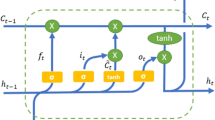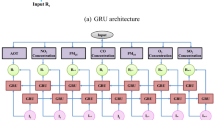Abstract
With the development of quality of life, people pay more and more attention to the surrounding environmental factors, especially air pollution. The problem of air pollution in China is becoming more and more serious, which poses a great threat to people’s health. Therefore, the prediction of air quality concentration is very important. PM2.5 is the primary indicator for evaluating the concentration of smog. Currently, studies have been proposed to predict the concentration of PM2.5. Before, most methods use traditional machine learning or real-time monitoring to predict pollution of PM2.5 value. However, the previous prediction methods cannot meet the requirement of the accuracy. For this end, this paper uses Convnet and Dense-based Bidirectional Gated Recurrent Unit to predict PM2.5 value which combined Convnet, Dense and Bi-GRU. The feature in air quality data was extracted from convnets without max-pooling instead another convolutional layer and Bi-GRU with additional Dense could provide a more accuracy result. Experiments show that the effectiveness of our method PM2.5 mass concentration prediction model provides a more superior method for PM2.5 mass concentration prediction.









Similar content being viewed by others
Data availability
All data can be downloaded from https://quotsoft.net/air/
References
Baowei Wang, Weiwen Kong, Hui Guan, Xiong Neal N (2019a) Air quality forecasting based on gated recurrent long short term memory model in internet of things. IEEE Access 7:69524–69534. https://doi.org/10.1109/access.2019.2917277
Baowei Wang, Weiwen Kong, Wei Li, Xiong Neal N (2019b) A dual-chaining watermark scheme for data integrity protection in internet of things. Comput Mater Continua 58(3):679–695. https://doi.org/10.32604/cmc.2019.06106
Baowei Wang, Wei Li, Xiong Neal N (2019c) Time-based access control for multi-attribute data in internet of things. Mobile Netw Appl. https://doi.org/10.1007/s11036-019-01327-2
Feng Lu, Dongqun Xu, Yibin Cheng, Shaoxia Dong, Chao Guo, Xue Jiang, Xiaoying Zheng (2015) Systematic review and meta-analysis of the adverse health effects of ambient pm2. 5 and pm10 pollution in the chinese population. Environ Res 136:196–204. https://doi.org/10.1016/j.envres.2014.06.029
Gers Felix A, Jürgen Schmidhuber, Fred Cummins (1999) Learning to forget: continual prediction with lstm. Neural Comput 12(10):2451–2471. https://doi.org/10.1049/cp:19991218
Giovanni Lonati, Michele Giugliano, Paola Butelli, Laura Romele, Ruggero Tardivo (2005) Major chemical components of pm2.5 in milan (italy). Atmos Environ 39(10):1925–1934
Harris Drucker, Burges Christopher JC, Linda Kaufman, Smola Alex J, Vladimir Vapnik (1997) Support vector regression machines. Adv Neural Inf Process Syst. https://doi.org/10.1007/978-0-387-77242-4_9
Jianzhou Wang, Bai Lu, Siqi Wang, Chen Wang (2019d) Research and application of a hybrid forecasting model based on secondary denoising and multi-objective optimization for an air pollution early warning system. J Clean Prod 234:54–70. https://doi.org/10.1016/j.jclepro.2019.06.201
Li Anna, Xu Xiao (2018) A new pm2.5 air pollution forecasting model based on data mining and bp neural network model. In: 2018 3rd International Conference on Communications, Information Management and Network Security (CIMNS 2018)
Lili Pan, Jiaohua Qin, Hao Chen, Xuyu Xiang, Cong Li, Ran Chen (2019) Image augmentation-based food recognition with convolutional neural networks. Comput Mater Continua 59(1):297–313. https://doi.org/10.32604/cmc.2019.04097
Mike Schuster, Paliwal Kuldip K (1997) Bidirectional recurrent neural networks. IEEE Trans Process 45(11):2673–2681. https://doi.org/10.1109/78.650093
Min Long, Yan Zeng (2019) Detecting iris liveness with batch normalized convolutional neural network. Comput Mater Continua 58(2):493–504. https://doi.org/10.32604/cmc.2019.04378
Min Xu, Pakorn Watanachaturaporn, Varshney Pramod K, Arora Manoj K (2005) Decision tree regression for soft classification of remote sensing data. Remote Sens Environ 97(3):322–336. https://doi.org/10.1016/j.rse.2005.05.008
Najafabadi Maryam M, Flavio Villanustre, Khoshgoftaar Taghi M, Naeem Seliya, Randall Wald, Edin Muharemagic (2015) Deep learning applications and challenges in big data analytics. J Big Data 2(1):1. https://doi.org/10.26599/bdma.2019.9020007
Qian-Rao FU (2016) School Of Science, and Northwestern Polytechnical University. Research on haze prediction based on multivariate linear regression. Comput Sci 43:526–528
Qing Tao, Fang Liu, Yong Li, Denis Sidorov (2019) Air pollution forecasting using a deep learning model based on 1d convnets and bidirectional gru. IEEE Access 7:76690–76698. https://doi.org/10.1109/access.2019.2921578
Ritika Singh, Shashi Srivastava (2016) Stock prediction using deep learning. Multimed Tools Appl. https://doi.org/10.31979/etd.bzmm-36m7
Samaher Al-Janabi (2020) Smart system to create an optimal higher education environment using ida and iots. Int J Comput Appl 42(3):244–259. https://doi.org/10.1080/1206212x.2018.1512460
Samaher Al-Janabi, Alkaim Ayad F (2020) A nifty collaborative analysis to predicting a novel tool (drflls) for missing values estimation. Soft Comput 24(1):555–569. https://doi.org/10.1007/s00500-019-03972-x
Samaher Al-Janabi, Muhammed Abaid Mahdi (2019) Evaluation prediction techniques to achievement an optimal biomedical analysis. Int J Grid Util Comput 10(5):512–527. https://doi.org/10.1504/ijguc.2019.102021
Samaher Al-Janabi, Alkaim Ayad F, Zuhal Adel (2020a) An innovative synthesis of deep learning techniques (dcapsnet & dcom) for generation electrical renewable energy from wind energy. Soft Comput 24(14):10943–10962. https://doi.org/10.1007/s00500-020-04905-9
Samaher Al-Janabi, Mustafa Mohammad, Ali Al-Sultan (2020b) A new method for prediction of air pollution based on intelligent computation. Soft Comput 24(1):661–680. https://doi.org/10.1007/s00500-019-04495-1
Seun Deleawe, Jim Kusznir, Brian Lamb, Cook Diane J (2010) Predicting air quality in smart environments. J Ambient Intell Smart Environ 2(2):145–154. https://doi.org/10.3233/ais-2010-00
Wei Hao, Lingyun Xiang, Yan Li, Peng Yang, Xiaobo Shen (2018) Reversible natural language watermarking using synonym substitution and arithmetic coding. Comput Mater Continua. https://doi.org/10.3970/cmc.2018.03510
Xinzheng Huang, Cornelis Oosterlee (2011) Generalized beta regression models for random loss-given-default. J Credit Risk 7(4):45–70
Yan Leiming, Wu Yaowen, Yan Luqi, Zhou Min (2018) Encoder-decoder model for forecast of pm2.5 concentration per hour. In: 2018 1st International Cognitive Cities Conference (IC3). pages 45–50. IEEE. https://doi.org/10.1109/ic3.2018.00020
Yuhong Zhang, Qinqin Wang, Yuling Li, Xindong Wu (2018) Sentiment classification based on piecewise pooling convolutional neural network. Comput Mater Continua 56:285–297. https://doi.org/10.30534/ijeter/2020/63892020
Zaremba Wojciech, Sutskever Ilya, Vinyals Oriol (2014) Recurrent neural network regularization. arXiv preprint arXiv:1409.2329
Zheng Yu, Liu Furui, Hsieh Hsun-Ping (2013) U-air: When urban air quality inference meets big data. In: Proceedings of the 19th ACM SIGKDD international conference on Knowledge discovery and data mining. pages 1436–1444. ACM. https://doi.org/10.1145/2487575.2488188
Acknowledgements
This work is supported by the National Natural Science Foundation of China under Grant 61972207, U1836208, U1836110, 61672290; the Major Program of the National Social Science Fund of China under Grant No. 17ZDA092, by the National Key R&D Program of China under grant 2018YFB1003205; by the Collaborative Innovation Center of Atmospheric Environment and Equipment Technology (CICAEET) fund, China; by the Priority Academic Program Development of Jiangsu Higher Education Institutions (PAPD) fund.
Funding
This work is supported by the National Natural Science Foundation of China under Grant 61972207, U1836208, U1836110, 61672290; the Major Program of the National Social Science Fund of China under Grant No. 17ZDA092, by the National Key R&D Program of China under grant 2018YFB1003205; by the Collaborative Innovation Center of Atmospheric Environment and Equipment Technology (CICAEET) fund, China; by the Priority Academic Program Development of Jiangsu Higher Education Institutions (PAPD) fund.
Author information
Authors and Affiliations
Corresponding author
Ethics declarations
Conflict of interest
The authors declare that they have no conflict of interest.
Code availability
All Codes are available from https://github.com/mc-boo/CDBGRU
Ethics approval
This article does not contain any studies with human participants or animals performed by any of the authors.
Informed Consent
Written informed consent for publication was obtained from all participants.
Additional information
Publisher's Note
Springer Nature remains neutral with regard to jurisdictional claims in published maps and institutional affiliations.
Rights and permissions
About this article
Cite this article
Wang, B., Kong, W. & Zhao, P. An air quality forecasting model based on improved convnet and RNN. Soft Comput 25, 9209–9218 (2021). https://doi.org/10.1007/s00500-021-05843-w
Accepted:
Published:
Issue Date:
DOI: https://doi.org/10.1007/s00500-021-05843-w




